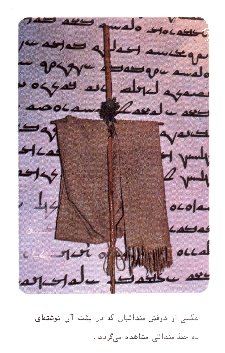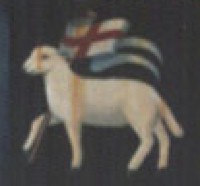
The Journal for the Study and Research into the
Mandaean Culture, Religion, and Language.
Volume 3 Special Issue Online edition
THE DRABŠA
RESEARCH DONE BY AJAE
COPYRIGHT 2000
The Idea of the Drabša
In Persian the word dirafsh is a "banner or standard, a flash of light or sunrise" (19). As we could see in the coin, the symbol is asociated Zoroasterism. It would appear that the banner in this respect is used to represent the symbol of the sun.
The Mandaean drabša the banner represents the light of heaven, God, i.e. a heavenly presence. I believe that this idea is very different than the banner as depicted on the coin. Although it is very possible that the word drabša was acquired by the Mandaeans prior to their exodus from Palestine, in or around 70 AD, I believe that the banner idea was already in use by the Mandaeans.
In Mandaic hymns the drabša is always a symbol of light:

"The Great (Life) rejoiced; It rejoiced when Yawar looked towards the banners of radiance and beams of light." (20)
"The brightness of the banner. Hath shone forth over the living waters!" (21)
"The banner, they took it from its pedestals of radiance to inner houses so that it was hidden. They cover it, bless it, guard it and say to it,"
"As surely as thy radiance waiteth safe in its casket, Will thy form be kept safe. All worlds which behold thee Will bless and praise thee for ever and aye". (22)
Figure #8
So where could this idea had come from?
In Christianity the banner denotes victory. Artists have depicted Jesus holding a banner when coming forth from the tomb. Also the Paschal lamb with a pennant is a symbol of a victory of life over death. But this symbol came after the Mandaeans had already migrated to Mesopotamia and we are already pushing the Mandaean existence back to pre-Christian. So this connection is not valid.

Figure #9
The Israelites also had banners. In this case these banners represented the 12 tribes. It was Moses who initiated these banners. But these banners do not represent God but rather family groups.
"Then the Levites will set out from the middle of the camp with the Tabernacle. All the tribes are to travel in the same order that they camp, each in position under the appropriate family banner." (24)
"Each tribe of Israel will have a designated camping area with its own family banner." (25)
Now the Israelites could have come into contact with Zoroasterism when they were exiled to Babylon. But if the idea of a banner as a sun symbol or symbol of God came into the religion at this time, it is not seen in the Jewish literature. We have the banner simply used as a representation of a people. So where as a Jewish banner idea does exist before the 70 AD mark, it is not consistent with the Mandaean banner in meaning. The banners do not represent the presence of God.
So where do we go from here. We can rule out Christian and Jewish influences. Zoroasterism influence is possible although the
Description
The Word Drabsa
Evidence of the Drabša in use during and after 70 AD
Evidence of Parthian Contact before 70 AD
The Idea of the Drabša
The Theory
References